
Who doesn't love the information imparted by a zealous local who guides you around their turf like a friend. Even better if he or she is a friend.
Oliver Nicholson is our friend, a native Brit from Devonshire whom we met in Minnesota. Mr. Nicholson (I shall henceforth call him Oliver) is a classicist, teaching medieval studies and Latin at the University of Minnesota. Tom met him while he was studying Latin (after Tom's first bout of retirement in 1997-8), and it was Oliver who encouraged Tom to spend the summer in Rome studying with Reggie Foster, the Pope's Latinist. Along the way we met Oliver's wife Caroline (an archeologist, archivist, and woman of many other talents), and their children. These days Caroline and Oliver live in the old country while Oliver continues to spend the school year in Minnesota. Along the way, Oliver served as our wine scribe for The Rake magazine, and we became fast friends. (You can check out his columns by searching http://www.rakemag.com/author/olivernicholson/)
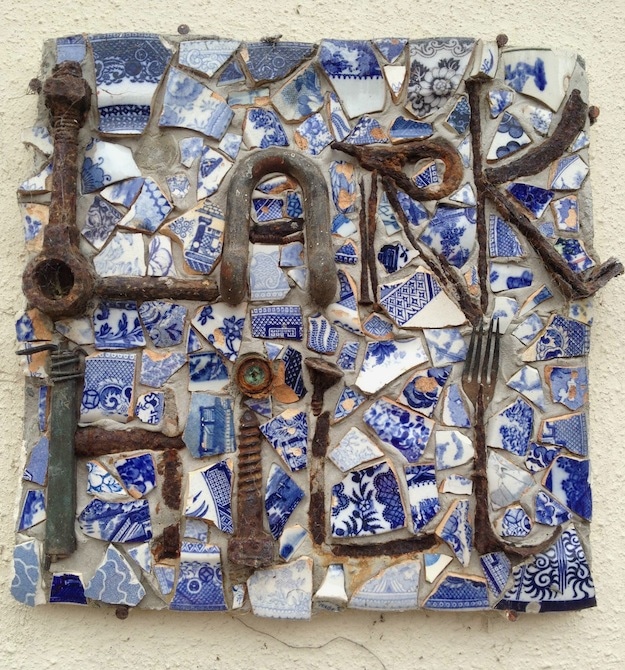
You can imagine, then, that both Oliver and Caroline are vastly interesting and knowledgeable guides. Happily for us, they were at their Lark Hill home outside of Tiverton, near Exeter, Devonshire, when we visited England this summer.
Some posts on Travel Past 50 may contain affiliate links. If you buy something through one of those links, we may earn a small commission. As an Amazon associate, we earn from qualifying purchases.
In Oliver's hometown, he pointed out the location of his father's doctor office, the select children's choir schools, and the shortcuts one takes through town. On our way to Exeter, he showed us some of the back roads his family would travel for Sunday or summer outings. While Oliver drove (he likes neutral gear whenever traffic slows), we learned the sorts of things that help you see the countryside in a timeless way. The county roads over the hills, for example, are the oldest, even dating back to Roman times. They were the shortest routes and suitable for horses and mules. The later, flatter roads were built when carriages, heavier loads, and eventually cars arrived in the countryside.
The hilly roads are most likely to be through woods, and the flatter roads are lined with stone walls built from agricultural clearing. Both are narrow, so we concentrated hard on the narrative as the left side of the car whipped along the hedges.
We learned Oliver could identify to within a few miles where the different color stones used in building churches came from.
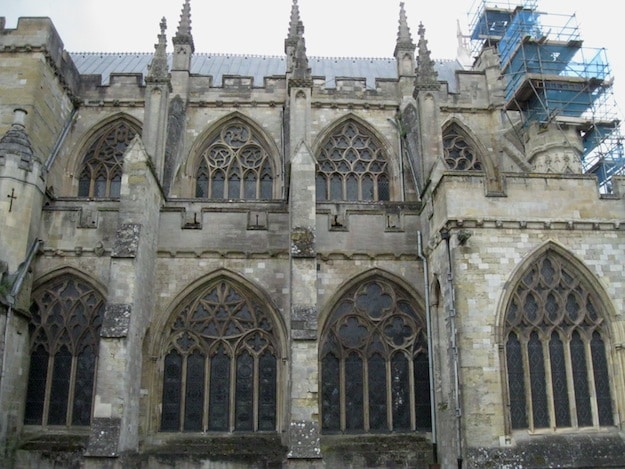
At the Exeter Cathedral's exterior, we admired the beautiful early Gothic (late medieval?) windows, constructed after vertical, pointed window shapes were introduced, but before the more absolute symmetry of high Gothic came into favor. Each is unique, likely the work of a distinct stonemasons with a unique vision. Oliver mentioned he'd spent many an hour trying to find repeating patterns in this emerging Gothic style.
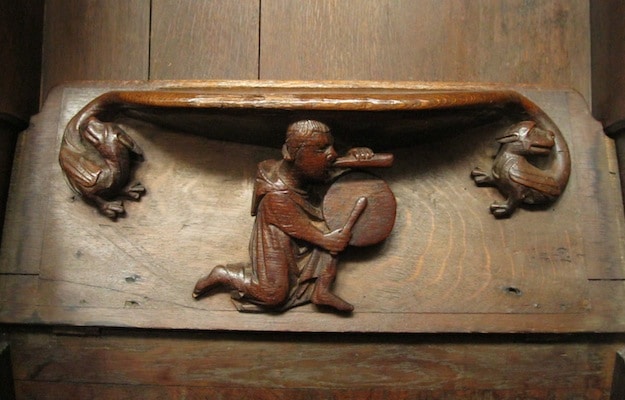
Inside, the long medieval vault is thick with spines meeting at round keystones–again all different from each other. Most guides will tell you the prominent keystone, the Becket Boss, depicts the murder of St. Thomas Becket. Other tour guides may or may not point out the relief with two left feet(!), the exact number of owls carved in one of the chapels (not telling), or the dozens of 13th Century misericord wood carvings on the underside of the choir seats. At any rate, the Exeter rondels, needlepoint cushions made in the 1980s relating the history of Exeter, are there for the browsing. (And they don't hold a candle to the needlepoint cushions in the Tiverton church. We know, because Oliver took us there.)
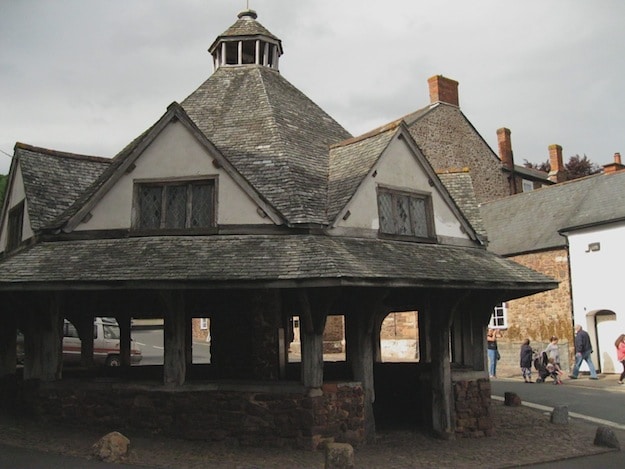
A day trip took us to Dunster Castle in Somerset. We packed sandwiches and stopped first in the old market in the center of town. We could easily imagine the wool vendors in a medieval version of the town. Up in the castle, Oliver pointed out inconsistencies in the table setting in the dining room. (According to the place cards, non-contemporaneous people appeared to be dining together.) With Oliver's prompting and Caroline's research, we spotted three Joshua Reynolds paintings among the collection. In the library, Oliver observed the books weren't original (reminding me of house hunting with Tom, who can't remember the floor plan but can tell you everything the owners read). Oliver asked the attendant about the stone surround for the library's fireplace, and the castle guards promised to get back to him with details.
After Dunster Castle, we realized we should have taken the National Trust deal, applying the admission fee to an annual membership. Eventually we bought the membership at the Avebury Ruins (near to and every bit as impressive as Stonehenge) and used our passes in multiple sites over the next weeks. If you are driving across England, be sure to join; it will pay for itself in free parking and free admission good at hundreds of England's National Trust sites.
We received some great recommendations for our drive north through Wells, Bath, Marlborough, Oxford, Stratford-Upon-Avon, and York on the way to Hadrian's Wall. Unfortunately, Oliver's work was to keep him at home, so he helped plan our itinerary and sent us on our way with much good advice.
“Look for the Indian restaurant behind the Town Hall” in Marlborough. (We did, and it was great. Look for Raj Indian Cuisine.)
“Stay in the ‘Castle and Ball' in Marlborough.” (We didn't, but wished we had. It was booked full the night we were there.)

“Visit the Wells Cathedral.” (We did. It's amazing for its great scissors arch and its elaborately vaulted chapter house.)
“Blenheim Castle is worthwhile.” Yes, indeed. It's the vast and historic castle of the Duke and Duchess of Marlborough, still occupied.
“Don't miss the grounds of Fountains Abbey [outside York].” We didn't, and that was a perfect last visit to a National Trust site before reaching Hadrian's Wall.
Of course we relied heavily on Oliver for recommendations along Hadrian's Wall, too, concentrating on the central portion between Haltwhistle and Hexham. This section has the most extant wall sections and fortifications and museums. If we'd only had Oliver to walk along the ramparts with us!
A visit with Oliver isn't complete without a few off-color limericks. I can't remember them from one minute to the next. I should have taken better notes (I always say that), especially walking beside such a fountain of information. But I can now take in a landscape or cathedral with a better sense of history and some understanding of the continuum of human impact. That's inspiring no matter where in the world you stand.
The moral of the story? When you are given recommendations, take them. When you are offered information, receive it. Some of it might stick.
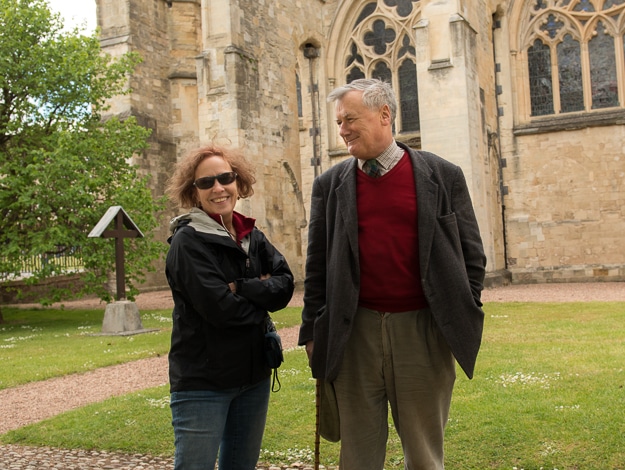

I am so glad you had a good time, m’dears.
The pleasure was all ours, kind sir.
What a perfect way to visit an area—-with a super enlightened, passionate local. When I lived in England for a year a loooong time ago (I had my 16th birthday there), we lived in Devizes, a Wiltshire market town between Avebury and Bath, so I enjoyed reading about your impressions of the area. Great trip. This post made me miss England.
Oliver is indeed all that, and knows a lot more about religious iconography than that lame hero of Dan Brown’s books.